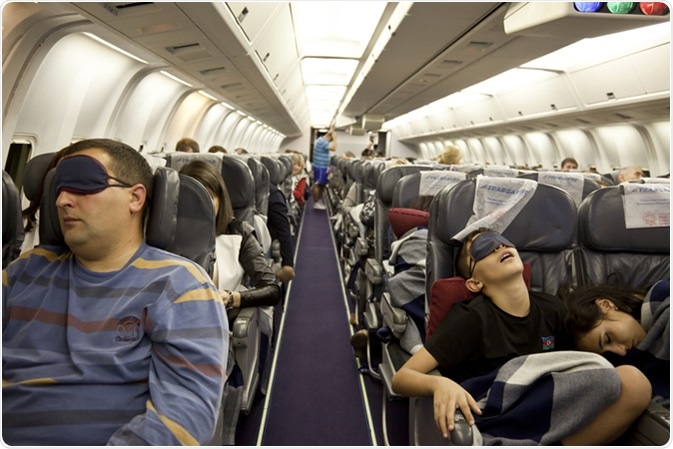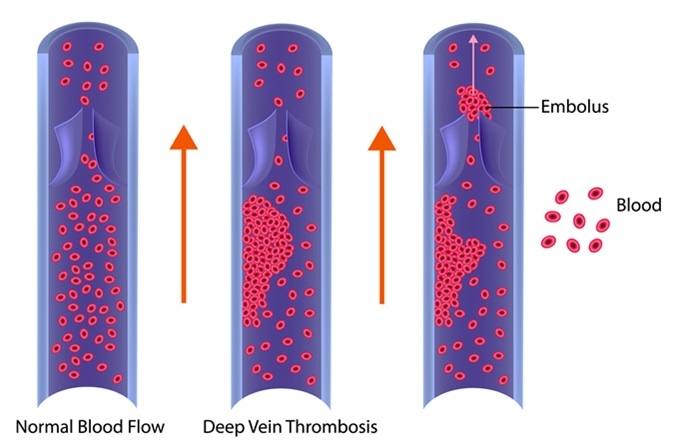
How Does Airplane Travel Affect the Human Body?
Written by Lois Zoppi, BA, reviewed by Sophie Mullany, BSc
Airplane travel is an increasingly easy and affordable mode of transportation.
There are a number of effects altitude and airplane travel have on the body, including oxygen deprivation, alteration of sleep patterns, and an increased risk of contracting contagious diseases.

Image Credit: Volkova Natalia / Shutterstock
Airplane Travel and Blood Oxygen Saturation
Travelling to high altitudes such as mountains or ski resorts pose a high risk of hypoxemia (oxygen deprivation) due to the decrease in oxygen pressure compared to sea-level. Typically, in-cabin air pressure is equivalent to that seen at 5000 to 8000 ft.
Local hypoxia causes vasodilation (decrease in blood pressure) and increased capillary permeability, as well as increased ventilatory effort and heart rate. One study found a passenger had a blood oxygen saturation of 94% at ground level and 85% at altitude. This study concluded that this hypoxia in conjunction with the dehydration, immobility and low humidity associated with airplane travel could contribute to morbidity during and after airplane travel.
Generally, blood oxygen saturation beneath 90% is not sustainable in the long term. Some respiratory physicians would even suggest oxygen supplementation for patients with blood oxygen saturation of less than 94%.
Airplane travel and sleep disturbances caused by air travel are frequently reported. Passengers who travel regularly are likely to change time zones and can experience circadian rhythm misalignment, leading to jet lag disorder (JLD). The incidence of jet lag increases with the number of time zones crossed.
The symptoms of jet lag are:
- Insomnia
- Feeling sleepy during the day
- Reduced performance
- Gastrointestinal problems
Generally, the effects of jet lag will wear off within a week. It is caused by a disruption of the circadian rhythm, which is maintained and controlled by melatonin from the pineal gland. Melatonin, when secreted, induces a heavy desire to sleep. Being in strong light stops melatonin secretion, but darkness triggers melatonin secretion, which may be imbalanced by crossing time zones or conditions inside the plane cabin.
Acute sleep deprivation, the main consequence of plane travel, can present the following issues:
- Reduced attention
- Altered mood states
- Reduced memory processing
- Altered executive functioning (cognitive ability to plan, manage time, direct resources, etc.)
The Effect of Low Humidity
Humidity levels in airplane cabins are around 5% to 20%. Optimal humidity is reported to be around 40% to 70%. The humidity depends on passenger load but can be as low as 2%.
As a result, travelers may experience:
- Dry nose
- Dry throat
- Dryness and discomfort in the eyes
Low humidity levels can make it easier for infections to spread, increasing the risk of contracting communicable diseases.
Health Risks Associated with Airplane Travel
Infection
One important current issue is that of the spread of infectious diseases through air travel. 2014 saw over 3.3 billion passengers travel by air from 41,000 airports, taking 50,000 routes worldwide, and passenger numbers are expected to reach 5.9 billion by 2030. The reported outbreaks of serious airborne diseases include:
- Tuberculosis
- Severe acute respiratory syndrome
- Influenza
- Smallpox
- Measles
The risk of passing on or contracting communicable infections is higher when confined in an enclosed space for a long period of time. Infections can be spread by inhaling airborne particles or by coming into contact with contaminated surfaces, body fluids or secretions. To limit and control infection outbreaks in-flight, HEPA filters can be used to remove infectious airborne particles in recirculated air.
On commercial jet aircrafts, the air inside the cabin is a combination of conditioned ambient air and air from the cabin itself that is filtered and recirculated. This is done to lower the number of contaminants in the cabin and to control temperature, pressure and ventilation.
A particular problem is that people are able to travel long distances within the typical 24-hour incubation period for contagious diseases, meaning passengers may remain asymptomatic for their entire journey, leaving any contagious diseases being carried by the passenger undetected until after their journey is complete.
Skin cancer
There have been studies suggesting a higher incidence rate of melanoma in pilots and cabin crew. This is possibly due to higher exposure to cosmic ionizing radiation, of which higher doses are found at altitude, and other recognized carcinogens.
Epidemiological conclusions are still to be made, and whether this increased risk of cancer in pilots and cabin crew is due to occupational or non-occupational factors remains unclear.
Deep venous thrombosis (DVT)
The risk of DVT is not limited to travel by airplane, and long-distance travelers by car, bus or train are also at risk.

Deep Vein Thrombosis or Blood Clots. Embolus. Image Credit: Sakurra / Shutterstock
In DVT, blood clots form in the deep veins as a consequence of sitting for a long period of time in a confined space. DVT can result in a pulmonary embolism, where a part of the blood clot breaks off and travels to the lungs. Risk factors for DVT are:
- Increased age
- Obesity
- Recent injury or surgery
- Estrogen-containing contraceptives
- Hormone replacement therapy (HRT)
- Pregnancy and postpartum period
- Family history of blood clots
- Cancer or recent cancer treatment
- Varicose veins
- Catheters placed in large veins
The symptoms of DVT include:
- Swelling leg or arm
- Pain or tenderness
- Warm or red skin
Summary
While there are a number of recognized effects and risks of airplane travel on the body, there is a paucity of information and most information is a result of observational studies. The general consensus is that more research needs to be done to definitively identify the effects and risks of airplane travel on the body. Recognized risks include the spread of communicable diseases, deep vein thrombosis, sleep disruption and blood oxygen saturation levels.
Sources
- http://europepmc.org/articles/PMC4006102
- www.asmscience.org/.../microbiolspec.IOL5-0009-2015
- https://adc.bmj.com/content/89/5/448
- https://www.cdc.gov/ncbddd/dvt/travel.html
- https://www.ncbi.nlm.nih.gov/pmc/articles/PMC3767878/
- https://www.ncbi.nlm.nih.gov/pmc/articles/PMC4006102/
- https://www.ncbi.nlm.nih.gov/pubmed/10678633
- https://www.ncbi.nlm.nih.gov/pubmed/26542037/
- https://www.sciencedirect.com/science/article/pii/S0012369213606881
Further Reading
Last Updated: Aug 9, 2018





















.jpg)










No hay comentarios:
Publicar un comentario